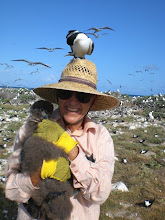



I finished work yesterday and spent much of today cleaning, returning borrowed books and materials and saying goodbye. I will leave tonight about 8:30 p.m. I have to pack my bag and do a little more house cleaning and then I'm going for a bike ride. Attached are a few pictures from my front yard to show the growth of the chicks over the past 3 months. The last picture shows a common strtching pose that is seen all over these days.
















































